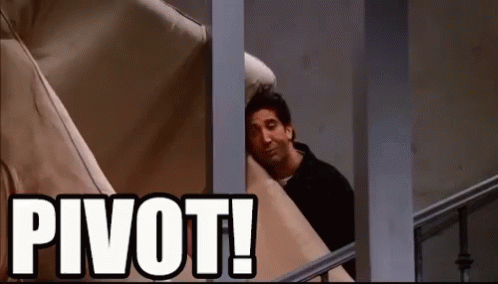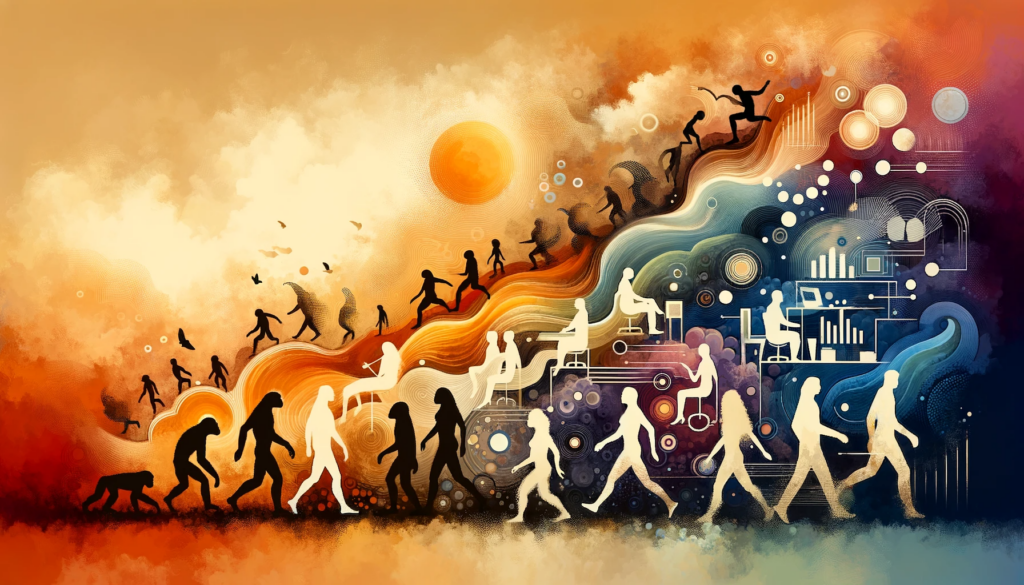Whenever I think about adaptability in marketing, I imagine today’s marketing scene as a staircase, and you’re Ross from “Friends,” maneuvering a couch—your well-crafted campaign—up to success. Suddenly, you hit a snag. The couch won’t fit; the market has shifted, Gen AI is rewriting the playbook, management is changing the game plan (AGAIN), budgets are slashed, and data is scattered. Do you drop the couch or, like Ross, do you keep yelling “PIVOT!” until you find a way?

In our everyday work life, it’s not just the monumental disruptions like Gen AI that test our mettle. More often, it’s the everyday shifts in strategy, the budget cuts, or the unexpected data privacy regulations that demand we pivot—swiftly and smartly—without dropping the ‘couch.’
For the best experience with this article, I advise you to use your best Morgan Freeman voice to read it. I’ve binged Life on our Planet this weekend, and this is what came out of it.
Adaptability: Your Ancestral Marketing Superpower
In the grand theatre of evolution, adaptability has been the center of humanity’s survival. It’s not only about reacting to change but embodying it, a concept that behavioral science traces back to our ancestors’ ability to master diverse and unforgiving environments. Today, this evolutionary prowess is as similar in the boardroom as it was in the ancient savannas.

The Plasticity of Marketing Minds
The word neuroplasticity comes to mind immediately. I am using this word because I feel it describes our adaptive skills more than anything. And guess what? This is imprinted in our DNAs. We are born to adapt and thrive.
Neuroplasticity, also known as neural plasticity or brain plasticity, is the ability of neural networks in the brain to change through growth and reorganization. It is when the brain is rewired to function in some way that differs from how it previously functioned.
Neuroplasticity – Wikipedia
Our brains are marvelously plastic, constantly reshaping themselves in response to new experiences.
In marketing, this neuroplasticity can be mirrored in strategies that evolve in real time. A marketer’s plan must be malleable, learning from the latest data and reshaping to fit the ever-changing mold of consumer preferences and market conditions. It’s about creating campaigns that are as adaptable as the minds conceiving them.
Teamwork and Survival: The Group Mind in Action
It's about fostering a culture where thinking outside the box isn't just encouraged—it's expected.
The social structures we’ve built, mirroring our “collaborative” ancestors (throwback to our tribal days), can be a blueprint for modern marketing departments much like the cooperative behaviors described by Axelrod and Hamilton.
Cross-functional teams combining diverse skill sets create a melting pot of ideas, fostering innovative solutions that can swiftly adapt to new market challenges. This cooperative spirit is what transforms individual adaptability into collective progress.
Innovation? It’s in our DNA, a thread that runs back to the dawn of tool-making. Just as our ancestors built tools to conquer new frontiers, today’s marketers craft campaigns and strategies to navigate digital challenges, market switches, and new technologies and innovations.
It’s about fostering a culture where thinking outside the box isn’t just encouraged—it’s expected. This is how a team, faced with challenges, can pivot to excellence.
Emotional adaptability, another evolutionary gift, equips marketing professionals with the resilience to face and bounce back from the unpredictable tides of market trends and consumer behaviors.
Building emotional intelligence within teams ensures they don’t just withstand the storms of change but sail through them.
Predictive Patterns and Experimental Mindset
Learning from history, both ancient and recent, allows us to identify patterns that can predict future outcomes. For marketers, this means scrutinizing consumer behavior and market trends to foresee shifts and proactively adjust strategies. It’s the same principle that helped our ancestors anticipate and prepare for seasonal changes, now applied to predicting market cycles and consumer evolution.
Marketers are agents of chaos.
Also, our propensity for strategic experimentation is an inheritance from our ancestors’ trial-and-error learning. In marketing, this translates to a culture of testing and learning—where A/B tests and iterative processes are the modern hunting grounds for success. Each experiment, each risk taken, is a step towards a breakthrough, much like the evolutionary adaptations that have carried us through millennia.
Human adaptability is vast and complex, but at its core, it’s about thriving amidst change. In the marketing and analytics world, tapping into these deep-seated evolutionary traits can turn adaptability into a true superpower, guiding brands through the ever-evolving consumer landscape with the wisdom of the ages.
In the end, adaptability in marketing is the subtle art of staying afloat in chaos. Marketers are agents of chaos.
It’s about keeping your campaign ‘couch’ airborne when the stairs of strategy get steep. It’s about embracing the new tools, like Gen AI, and using them to enhance creativity rather than viewing them as threats.
The Pivotal Pivot: Analytic Agility in Chaos
For digital analysts, the pivot is about turning chaos into clarity. When the data doesn’t fit the model when tracking issues throw off your insight—what do you do? You pivot not just in strategy but in mindset.
You anticipate, you adapt, you overcome.
Adaptability isn’t just a buzzword; it’s a survival skill in marketing and analytics. Especially if you are working in an agency. To pivot like a pro, you must adopt a blend of historical wisdom, contemporary agility, and a dash of predictive prowess.
Let’s break it down with some practical examples from the history of marketing.
Stay focused on learning and updating your skills and knowledge.
The marketing world is littered with the remnants of those who failed to adapt.
Take Blockbuster’s fall to Netflix—a classic tale of a giant who failed to pivot with changing consumer behaviors and technology. Don’t be Blockbuster. Embrace new platforms, technologies, and methodologies before they become industry standards.
Subscribe to marketing digests, take online courses, and attend webinars. Your future self will thank you.
Keep your ears in the market and your fingers on its pulse.
When Coca-Cola introduced New Coke in 1985, it was a marketing mishap that quickly became a lesson in rapid response.
The Coca‑Cola Company took arguably the biggest risk in consumer goods history, announcing that it was changing the formula for the world’s most popular soft drink, and spawning consumer angst the likes of which no business has ever seen.
New Coke: The Most Memorable Marketing Blunder Ever?
By listening to consumer outrage and swiftly bringing back Coca-Cola Classic, they pivoted from a potential disaster to reinforcing brand loyalty. Create a framework for your team that identifies key performance indicators (KPIs), tracks real-time consumer feedback, and outlines swift response strategies.
Not sure how to get started? Check out my article on how to properly use Natural Language Processing to learn how to understand and engage with your market.
If you are in a leadership position, foster a risk-taking culture.
Google Glass might not have been the consumer hit Google hoped for, but it paved the way for further innovation in AR technology.
Naturally, given the somewhat silly look of Google Glass, it’s no surprise that critics weren’t very kind to the product. Even with its many cutting-edge applications within the field of medicine, critics were quick to point out the ridiculous look of Google Glass. You may recall the nickname ‘glassholes,’ which was quickly and widely adopted in reference to those seen walking around wearing Google Glass.
The Real Reason Google Glass Failed Spectacularly
Encourage your team to pitch ideas that could be the next big thing.
Cultivate an environment where ‘failures’ are seen as stepping stones to the next breakthrough.
Create space for mindfulness in the chaos.
Think about the 2020 pandemic and how companies pivoted to remote work, which led to a surge in digital marketing opportunities. Marketers who were mindful and present recognized and capitalized on these new channels quickly. When things don’t go as planned, take a step back, assess the situation calmly, and look for the silver lining.
No time for comfort zones.
Remember Kodak’s reluctance to pivot from film to digital?
That is a well-documented example of a company stuck in its comfort zone, ultimately leading to its downfall. Regularly push your boundaries.
Experiment with different marketing tactics, explore new audience segments, and don’t shy away from the unconventional. Pivoting isn’t just about big shifts; it’s about the small steps out of your comfort zone that accumulate over time.
Conclusions
I’ve been there, shouting “PIVOT!” at the universe when a strategy falls flat because of a sudden budget cut or an algorithm change. It’s frustrating, it’s challenging, but it’s also invigorating. Why? It’s in these moments that we grow the most—not just as marketers or analysts, but as leaders.
Remember, adapting and thriving are in our DNAs, and as we saw in many moments in the history of marketing, we used our ancestral superpowers; nothing can stop us next time things take us by surprise. We got this.
Ultimately, whether it’s a disruptive technology like Gen AI or the daily grind of shifting business sands, our success is defined by our ability to adapt and pivot.
So the next time your ‘couch’ won’t fit up the stairs, channel your inner Ross and pivot with purpose. And remember, even if you end up with a little ‘pivot’ in your step, that couch is getting upstairs.
